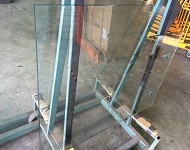Intelligent Interlayers and Laminated Electric Glass
Thermochromic Film
The most promising approach to thermochromic layers for windows involves thermochromic materials incorporated into plastic films such as PVB. Thermochromic materials used in a window’s laminate-interlayer/film reversibly change from less light absorbing, to more light absorbing as the temperature of the materials is increased. As they are reversible, they also decrease in light absorption as the temperature is decreased. This is sometimes referred to as ‘intelligent’ glass.
Electrochromic Glass
Electrochromic (EC) glass consists of two glass panes coated with complementary electrochromic thin films on a transparent conductive oxide coating (TCO). The two panes are then laminated with an ion-conducting polymer electrolyte (PVB) interlayer using standard laminated glazing processes. Wire leads extending from one edge are tied into a low voltage control system that is powered by the building’s electrical system. The window can also be powered using photovoltaic cells to avoid the cost of routing the wiring to the glass. Once installed, the windows or skylights can be operated by a manual switch or remote controller, a simple stand-alone automatic system, or a sophisticated central energy management system that integrates its operation with other building systems such as the electric lighting and mechanical system.
Electrochromism is defined as the reversible change of the optical properties of a material induced by electrochemical oxidation and reduction due to an applied DC voltage. The most popular device construction for electrochromic elements in architectural applications is solid films, joined together by an electrolyte – preferably a solid polymer electrolyte (battery type). This device construction has a memory effect and needs current flow only during switching. Due to the application of a small DC voltage a current flow is induced which is accompanied by a change in optical transmittance of the glazing (coloration or charging). If the voltage is switched off the glazing retains its optical transmittance. By short circuiting or reversing the applied voltage, the current flows in the opposite direction and the glazing bleaches (discharging). A controlled, gradual change of the light transmittance is possible however – but will not be covered in this article. EC glass is also being incorporated with Low E glass in IGUs (double glazed units), creating another effective Energy-Saving glazing product option.
PDLC, or Polymer-dispersed Liquid Crystal Film
Also named privacy film, smart film, magic film, switchable film used to make Switchable Privacy Glass.
For those with an interest in its chemistry, I recommend this site: New Polymer Networks for PDLC Films
The PDLC matrix comes supported either side by ITO (Indium tin oxide) film, then a PET (Polyethylene terephthalate) film, then either EVA, PVB or TPU film before being laminated between two sheets of glass.

